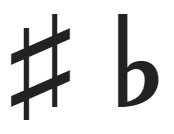Chords by notes
There are twelve different pitches, or notes, in music. In chord names, the root note is always written out and chords are often referred to as a C chord, a D chord and so on.
Choose from note (no flats or sharps):
Choose from note (flats and sharps):
The letters: C, D, E, F, G, A and B
In music, we are using the letters C, D, E, F, G, A and B (in some countries H). These are names of notes, or pitches, as well as name of chords, or part of chord names. It's not the same thing though, a C note is just a note, whereas a C chord includes a couple of notes with C as the root note.
Sharps (#) and flats (b)
 In chord names and in many other circumstances, flats and sharps are written in the symbols # and b, respectively. The flat means that a tone is flattened and the sharp means that a tone is raised.
In chord names and in many other circumstances, flats and sharps are written in the symbols # and b, respectively. The flat means that a tone is flattened and the sharp means that a tone is raised.
So, a Db is a D that is flattened one semi-step (a whole step would made it to a C). And accordingly, a D# is a D that is raised one semi-step (a whole step would made it to an E).
Often confusing is the fact that b and # can occur in different chord names, but referring to identical chords. D# and Eb are actually the same tone or chord (if read as chord symbols). The reason why two symbols are used for the same thing is that the musical context, in this case the key, change. For example, in the key of B major D# is used, whereas Eb is used for the same note in the key of Ab major.
If you're still confused, just remember that D# and Eb are, practically speaking, the same thing. Here are all the cases of sharps and flats being the "same thing":
- C# and Db
- D# and Eb
- F# and Gb
- G# and Ab
- A# and Bb
Does that mean that B#, Cb, E# and Fb doesn't exist? Concerning chords, yes. However, B#, Cb, E# and Fb are sometimes used as an alternative reference to notes. For example, in the chord C#13 the notes is written either C# - F - G# - B - D# - F# - A# or C# - E# - G# - B - D# - F# - A#. The second version includes an E# and this is to avoid that F is included twice, which in some cases can confuse things.
The instrument and the notes
A guitar in standard tuning will favor some chords and disfavour other in terms of how smoth the chords can be fingered. In general, chords with natural root notes are easier to play.
For pdf, see The Chord Reference ebook with over 800 chord charts.
How to remember chords?
As you learn new chords, you will by time forgot some old. But, as you get used to your instrument and learn the notes on the fingerboard, you will begin to find the chord shapes more logical. In addition, it's not only about memorizing exact positions since many shapes will return in various configurations. By time you will recognize such shapes and more often remember what to play.